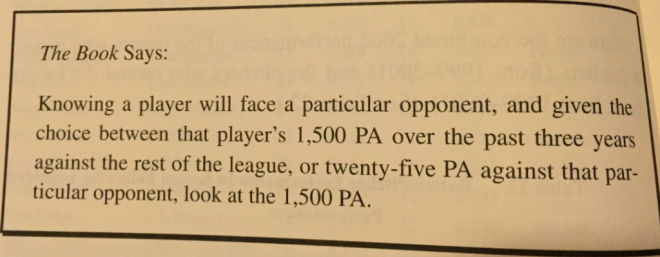Using Batter vs Pitcher (BvP) in Fantasy Baseball
The Batter vs Pitcher (BvP) stat is a controversial one in daily fantasy baseball. BvP is an individual batter’s career stats against the pitcher he is facing. And there is a big debate as to whether it is a good or bad tool for DFS research. One side laughs at those who use it, while the other side can’t believe anyone would not use it.
This debate has been going on for years and it will likely continue for many more. This article will attempt to lay out the argument from both sides and explain exactly how to use (and not use) BvP stats.
The true disciples of sabermetrics are the leading the anti-BvP crusade. The sample sizes are too small to provide predictive value, rendering the stat no better than an individual player’s career average on Tuesdays.
The other end of the spectrum is the BvPlievers. If they see a guy with a great BvP stats, he is going in their lineup immediately. When Paul Goldschmidt faces Tim Lincecum, it is a national holiday for these people.
Then you have the people in between. They can often be found telling people that they “only use BvP to break ties.” Truthfully, this group might be the worst of all. At least the other two believe in something. The other two groups have at least consider whether BvP is a good/bad stat and reacted accordingly. If you think BvP has no predictive value, you would never use it. If you think it does have predictive value, you would obviously be using it as a main tool. The people in this group are in between, so they don’t even know if this is a good or a bad stat, they just work it in when it is convenient. Either that or they are BvPlievers that are just afraid to admit it.
The Argument For Batter vs Pitcher
The argument for Better vs Pitcher relies on the human element. BvPlievers like to talk about when they played the game. “Everyone knows that you hit certain pitchers better than others.” Major Leaguers have echoed this sentiment as well, so not only former JV baseball players believe it.
So if some hitters matchup well with a certain pitcher, the BvP stats will likely bear that out. Even if the sample size is small, some numbers are too good to be luck. If a guy has ridiculous stats against a pitcher, he clearly has some advantage over him, for one reason or another.
And the nice part about BvP stats is that they are easily accessible. You can find some batters in terrific matchups with one click of a button, shaving valuable time over your research process.
The Argument Against Batter vs Pitcher

The Book is The Book: Playing the Percentages in Baseball by Tom Tango, Michael Litchman and Andrew Dolphin. It is basically the baseball equivalent of the Bible for sabermetrics.
The argument against BvP is simply that it is not a predictive stat. Stats come in many forms, some are predictive, some are descriptive, and some are both. BvP is descriptive. It tells us what happened, but doesn’t really tell us what is likely going to happen in the future. A stat like wOBA tells us what happened, and given a large enough sample size, it can be useful in attempting to predict future outcomes, as The Book alludes to.
And the sample size is really the crux of the Batter vs Pitcher issue. I think everyone would agree that certain hitters matchup well with certain pitchers, but BvP can yield a lot of false positives.
By far, my favorite BvP argument goes something like this: anti-BvP person cites sample size issue. Pro-BvP person comes back with a player that was 50 ABs, expecting the anti-BvP person to be impressed. They never are.
Here is why. That page has the stablization rates for pretty much all the major stats. When a stat hits the given mark on that page, it can be viewed as “reliable”. Now obviously skills are always improving/declining and adjustments are being made, but that page is a good guide on when something might be “real” and when it is just small sample size variance. You may notice that the quickest stabilization rate for a hitter is strikeout rate, which requires 60 PAs. Everything else is over 100 PAs. I have yet to see a BvP matchup that had 100 ABs.
Even if the BvP matchup had 60, those plate appearances would likely be stretched over many years (7+) to the point where the earlier ones were no longer relevant.
And the argument that tons of success in small samples is a sign that a batter “owns” a certain pitcher doesn’t really hold water. Let’s say Batter A is facing Pitcher Z. We know (don’t ask me how) that given 1000 PAs against the pitcher, Batter A would hit .250. So he is a true talent .250 hitter when facing this pitcher, meaning he will likely get one hit every four ABs against him.
If you look at the binomial distribution of 10 ABs (n=10, p= .25), Batter A has a 22.4% chance of going 4-for-10 or better. Is it likely? No. But 22.4% is not nothing. That means that if we have five players that we know are a .250 hitter in a given matchup, one of those five will likely look like a .400 hitter over a 10 PA stretch.
Remember that next time someone is trying to sell you on an extremely small sample.
How to Use Batter vs Pitcher Stats
Personally, I am in the anti-BvP camp (as you probably could have guessed). I don’t use it in my writing and I never seek it out in my research. But in my opinion, there are two ways that it can be used (successfully) in daily fantasy baseball.
1. Help to Determine Ownership %
If you play tournaments, you know how important predicting ownership % can be. BvP is a commonly used tool for daily fantasy. The better the BvP matchup a player has, the more likely they are to receive a boost in ownership %. If you are looking to go contrarian, you can purposely avoid the best BvP matchups and take other guys at those positions to differentiate yourself.
2. As a Clue
BvP is descriptive and some of the great BvP matchups are just statistical noise. But others are real. Looking at a list of the top BvP players will give you some players that fall into each category. But if you use it as a clue and decide to dig deeper on it, you may be able to identify the great matchups on a deeper level.
That can be as a simple as platoon splits or something complex like the pitches that are pitchers throws or the locations in the zone he likes to work. Say a pitcher throws a large percentage of his fastballs in the upper third of the strike zone. A batter’s history against fastballs in the upper third of the zone will likely have a lot more at bats than his history against that given pitcher. If we can find evidence that this player is a great high fastball hitter, we might have just uncovered a great matchup.
If you are going to use BvP in your research, it should go hand-in-hand with further research to see why the player has been successful and if there is evidence to suggest it might be “real”.
